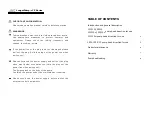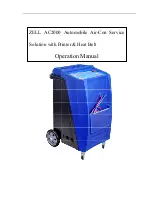
HYDROBOX
™
Operations And Maintenance Manual
INTRODUCTION 1-2
©
2006 SyQwest Incorporated
1)
An introduction (this section), which provides a system overview and basic outline of echosounding
acoustics.
2)
Installation, which provides details on how to properly mount all of the HydroBox System
components. Details on installing the HydroBox PC Software package are included also.
3)
Operational instructions describing how to operate the HydroBox Sensor unit and the HydroBox PC
Software.
4)
Maintenance, which provides information on replaceable parts and troubleshooting guidelines.
The user should pay attention to notes that are displayed in a gray box. These notes contain important
information regarding installation and use of the HydroBox System. An example is given below:
NOTE: Important operation and installation information is provided in gray boxes
throughout the manual.
1.3
Echo Sounding Principles
Basic echo sounding principles that should be understood by all operators of hydrographic equipment are
provided in this section.
1.3.1
Underwater Acoustics
1.3.1.1
Decibels
The scale most often used to describe a measurement unit of sound is the decibel (abbreviated “dB”). The
decibel system was selected for a number of reasons. First, it is a logarithmic system, which is useful for
dealing with large changes in measured quantities. Decibel units make multiplication and division simple
because they are reduced to an addition and a subtraction operation respectively. Secondly, for
underwater acoustics, the primary concern is ratios of power levels and signal levels rather than absolute
numeric values.
Transducer calibration values are typically provided in units of decibels, including source level, receive
sensitivity and directivity index. These transducer calibration values are outlined later in this section.
These quantities are used to predict performance levels of a given transducer used with a sonar system.
1.3.1.2
Sound Propagation
The sea, together with its boundaries, forms a remarkably complex medium for the propagation of sound.
Figure 1-2 shows the interaction of a transmitted sound source and the water. Both signal loss and
interference result from interactions with boundaries and components within the water column, causing
the source to be delayed, distorted and weakened. The main components affecting sound propagation are
spreading loss and attenuation loss.
Spreading Loss
As a transmitted pulse of sound leaves the transducer, it spreads out in all directions. At the transmission
point, the sonar puts a fixed amount of energy into the water. As the pulse travels away from the
transducer, it occupies a greater and greater volume. This effect is called spherical spreading. The
general rule is that the intensity of the sound falls off as the square of the distance traveled. In respect to
typical acoustic measurements, this mathematically becomes a loss of 6 decibels for each doubling of the
distance.
Summary of Contents for HydroBox
Page 2: ......







































